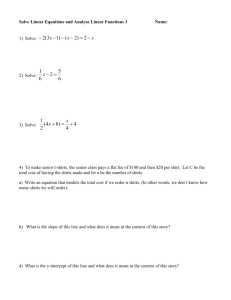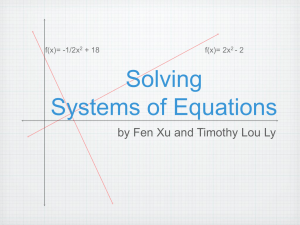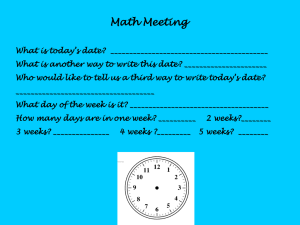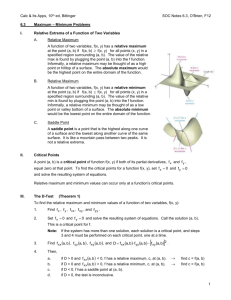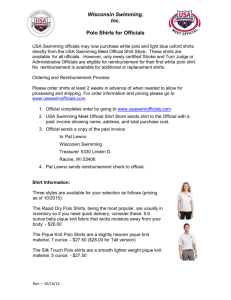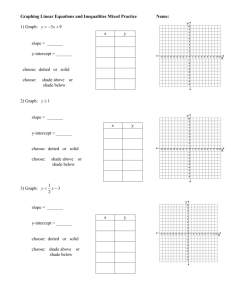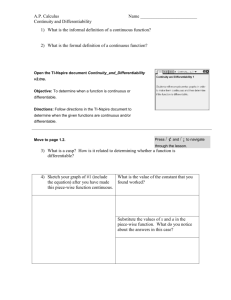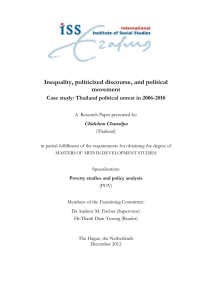MATH 1101 Note Sheet Function A function is a process that takes
advertisement
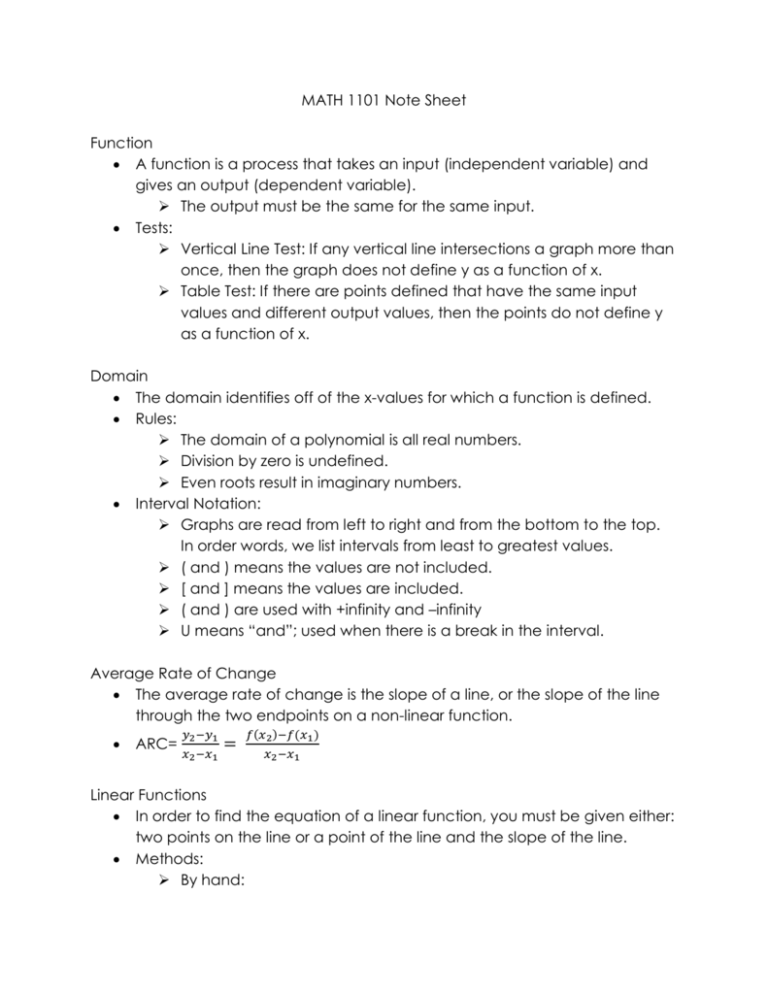
MATH 1101 Note Sheet Function A function is a process that takes an input (independent variable) and gives an output (dependent variable). The output must be the same for the same input. Tests: Vertical Line Test: If any vertical line intersections a graph more than once, then the graph does not define y as a function of x. Table Test: If there are points defined that have the same input values and different output values, then the points do not define y as a function of x. Domain The domain identifies off of the x-values for which a function is defined. Rules: The domain of a polynomial is all real numbers. Division by zero is undefined. Even roots result in imaginary numbers. Interval Notation: Graphs are read from left to right and from the bottom to the top. In order words, we list intervals from least to greatest values. ( and ) means the values are not included. [ and ] means the values are included. ( and ) are used with +infinity and –infinity U means “and”; used when there is a break in the interval. Average Rate of Change The average rate of change is the slope of a line, or the slope of the line through the two endpoints on a non-linear function. ARC= 𝑦2 −𝑦1 𝑥2 −𝑥1 = 𝑓(𝑥2 )−𝑓(𝑥1 ) 𝑥2 −𝑥1 Linear Functions In order to find the equation of a linear function, you must be given either: two points on the line or a point of the line and the slope of the line. Methods: By hand: Find the slope of the line if it was not given: 𝑦 − 𝑦1 𝑚= 2 𝑥2 − 𝑥1 Use either the point-slope formula or the slope-intercept formula to find the equation of the line by using the slope and a point on the line. 𝑦 − 𝑦1 = 𝑚(𝑥 − 𝑥1 ) or 𝑦 = 𝑚𝑥 + 𝑏 Using your calculator: Input the x- and y-values into 𝐿1 and 𝐿2 ; then use LinReg to find the equation of the line. Piece-Wise Functions Find the endpoints of each section. Find the linear function for each section using one of the methods from above. Assemble these function into a single piece-wise function, indicating the domain for each section. Finding Average Error 1. Put the given x-values into 𝐿1 and the given y-values into 𝐿2 . 2. Find the Linear Regression Model that best fits the given data and store it in 𝑌1 . 3. Calculate your predicted y-values using the linear model that you have found by inputting the x-values from 𝐿1 . This is entered into column 𝐿3 as 𝑌1 (𝐿1 ). 4. Calculate the error between the given y-values and the predicted yvalues using your model. This is entered into column 𝐿4 as 𝐿3 − 𝐿2 or 𝐿2 − 𝐿3 . 5. Calculate the squared errors by entering 𝐿4 2 into column 𝐿5 . 6. Quit to the main screen (2nd QUIT) 7. Enter sum(𝐿5 ) in order to calculate the Sum of the Squared Errors (SSE). 8. Average Error = √ 𝑆𝑆𝐸 𝑛 , where n is the number of given data points. MATH 1101 Practice Test 1 1. Given the data below: A 3 -5 B 10 12 6 14 3 16 10 18 a) Is A a function of B? b) Is B a function of A? 2. Is y a function of x? −5𝑥 + 10𝑦 2 = √20 3. Does the following represent the graph of a function? 4. Find the domain of the following functions: a) 𝑓(𝑥) = 5𝑥 2 + 10𝑥 − 15 b) 𝑓(𝑥) = 3𝑥−9 𝑥 2 −81 c) 𝑓(𝑥) = √5𝑥 + 25 3 d) 𝑓(𝑥) = √2𝑥 − 6 e) 𝑓(𝑥) = √8𝑥−64 2𝑥−24 f) 𝑓(𝑥) = 15𝑥+20 √3𝑥+18 12 20 5. Find the average rate of change between each set of points given in the table below: x -10 -5 5 15 20 f(x) 5 15 55 15 -20 ARC a) Does this table of data represent points on a linear function? b) Over which intervals is this function increasing and decreasing? c) This function is increasing at an ______________ rate and decreasing at a ________________ rate. 6. A local T-shirt company sold 850 shirts two weeks ago when they charged $15 for each shirt. The following week the company found that for every $3 the discounted the price per shirt, 150 more shirts would sell. a) Find a linear function that models the number of shirts, S, the store will sell in a week based on the price, p, that is changed per shirt. b) Predict the number of shirts that the store would sell in a week if they changed $20 for each shirt. c) What price per shirt would cause the store to sell no shirts? 7. You are heading to the Georgia vs. Florida game!!!! You begin your trip driving 45mph for 1 hour before you realize that you have left your lucky pom-pom at home! You drive back home at a speed of 90mph to get your pom-pom. You then set off again driving 60mph for the next 3 hours. You decide to stop for lunch for 30 minutes. After lunch you drive the remaining 2 hours of the trip at a speed of 55 miles per hour. GO DAWGS! Let d(t) represent the total number of miles that you have traveled away from home and t represent the number of hours. a) Write a piece-wise function that represents the trip described. b) How many miles away from home have you traveled after 3 hours of your trip? c) After how many hours will you have reached a distance of 200 miles from home? 8. We are given the following data for the population, P, of a town, in thousands, for the given years. Let t represent the number of years after 1970. Year 1970 1980 1990 2000 2010 Population 12 26 70 87 93 a) Find the linear regression model that best fits the given data. b) Find the SSE for this data. c) Find the Average Error for the model. d) Use your model to predict the population of the town on Jan. 1, 2015. e) In what month and year would you predict that the population of the town to reach 150 thousand? 9. Find the piece-wise function for the following graph: 10. A jewelry store made a profit of $600 thousand in the year 1990. From the years 1990 to 2000 their profit decreased at a constant rate of $10.5 thousand per year. For the years after 2000, the store experienced a constant increase in their profit at a rate of $5.25 thousand each year. Let P represent the yearly profit of the store and t represent the number of years after 1990. a) Find the piece-wise function that represents the profit of the store as a function of time. b) In which year would you expect for the profit of the store to reach $800 thousand? c) What do you predict the profit of the store to be in 1998?
